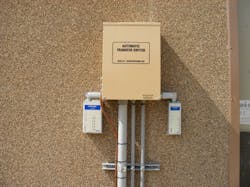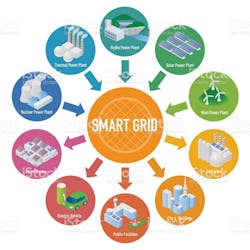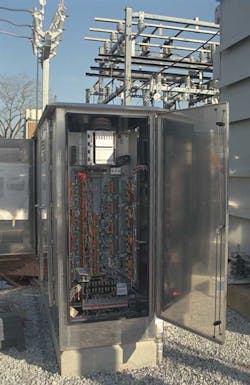Amid growing excitement for smart grid innovation, proper grounding, bonding and surge protection can be an area of oversight for busy utility engineers, electricians and installers tasked with managing an ever-growing inventory of microprocessor-based equipment. Traditional grid elements are less sensitive to destructive transient surge events and power quality issues than today’s digital devices that function on a lower power level and order of magnitude. With smart grid technologies quickly taking shape, it is important to consider electrical protection solutions from the ground up to prevent costly problems and service disruptions down the road.
Think Safety and Surge Protection
As the Department of Energy (DOE) notes, it will take some time to perfect the millions of pieces and parts that will form future smart grids—everything from computers to controls to completely new equipment. Today, many of these technologies are being tested and perfected with an eye on broad-scale deployment in the coming decade. This transformation can be dramatic adds the DOE, changing the way people live, work and play as fundamentally as the internet.
Two-way data dialogue promises to make primary power networks and adjoining microgrids more efficient, reliable and secure, but this can only happen when smart systems are protected from severe levels of current surges and transient voltages. Any device that manages data traffic and/or supports network connectivity must be considered for surge protection and not just the safety of the system.
For instance, at typical voltage distribution levels, spark gap-style medium- and high-voltage metal oxide arresters are commonly used to address lightning events across the grid. The problem is that these devices tend to permit a higher level of voltage let-through than most sensitive electronic equipment can handle. It is also often the case that engineering groups employ surge protection principles under the guidance of traditional control panel design when in fact, new digital technologies demand new techniques.
A Systems Approach
Often overlooked is how grounding, bonding and surge protection are interdependent disciplines. From the ground up, reliable protection of smart grid elements requires a systematic approach to minimizing threats caused by transients. For instance, no air terminal or high-voltage arrester can safely capture lightning energy without a dependable route to ground, and even the most expensive surge protection devices (SPDs) are poor performers without a low impedance electrical ground. At the same time, a low impedance ground may not create the desired safety effect if good installation bonding practices are not followed.
Even with the best grounding and bonding system, transients can cause a loss of electrical equipment making coordinated surge protection critical to reducing the impact of these low-magnitude events (pictured are SPDs retrofitted to a utility control house generator ATS).
Failing to address any one aspect of proper electrical protection invites difficulties when striving to keep smart systems online, given that most equipment driven by semiconductors has a very low tolerance for electric disturbances. Where protective measures are inadequate, a single lightning strike or voltage rise event can incur tens of thousands of dollars or more in damages including lost revenues, emergency repairs, labor expense and equipment replacement. In the worst-case scenarios, a complete grid failure can occur. Meanwhile, more than one utility manager has complained how service team morale suffers when digital devices become a daily distraction.
Smart grids will encompass not only conventional power elements but also solar PV, wind energy, electric vehicle and energy storage systems, putting the focus on how to integrate these components in parallel with primary infrastructure. Increasingly, utilities are applying microgrid design concepts to their smart grid schemes, where systems with faults can be shut down and disconnected from the broader grid to isolate potential problems. Many smart grids can operate at a level where problems can be detected and addressed before a failure occurs, and system efficiency can be dramatically improved with grids being micro monitored.
There is a lot to consider when it comes to devising compatible electrical protection solutions for the countless combinations of smart grid elements that can be encountered. From advanced energy meters to pole-mounted sensor nodes to transmitters tucked inside enclosures, surge protection can be added to virtually any application and environment. As these technologies evolve and new elements emerge, it is advisable to seek the insight of a qualified grounding, bonding and surge protection specialist who has experience with a wide variety of operation and energy measures.
Smart grids will comprise a variety of interconnected energy systems and elements—there is even talk of city intersections that charge electrical vehicles while they idle at stop lights.
Collaboration is Key
Unfortunately, many utilities are discovering the elevated risk to delicate instrumentation only after damage has occurred. Today, the mounting cost of network maintenance is driving greater awareness for proper usage of SPDs that prevent equipment failures and outages.
Some utilities have found effective practices for increasing system reliability with the usage of SPDs while others are still working to understand the issues and put layers of protection in place. Importantly, smart grid protection starts with an understanding of system approaches for SPD implementation involving Power, System I/O and Network/Data Communications. This requires close coordination between the Power, Instrumentation & Control (I&C) and Supervisory Control and Data Acquisition (SCADA) engineering teams as well as outside partners and suppliers so that problems do not remain segmented. Smart grid implementation promises to bring all disciplines together—electrical, engineering and otherwise—meaning a broader perspective and communication among peers will be essential to identifying emerging challenges and deploying swift, effective solutions.
Organizations including the Institute of Electrical and Electronics Engineers (IEEE) and American National Standards Institute (ANSI) offer education and training for professionals wanting to explore stronger surge protection strategies. Information is also available from many electrical products makers and groups like the National Electrical Manufacturers Association (NEMA) who can help bring specific areas of learning into focus.
Setting New Standards
Grounding, bonding and surge protection should always be considered as one cohesive element of an electrical protection solution that is built to last. Knowing how to build the best smart grid solutions can be difficult, however, as today’s technologies seem to change every day while electrical codes can take years to create. As industry standards committees work to develop new guidelines, continued dialogue across disciplines will be essential for incorporating surge protection into smart grid systems.
Transmission and distribution topology will only become more complicated as smart grid elements propagate power networks, making damage prevention essential to grid modernization efforts. Today many utilities are keen to implement smart grid surge protection, and this is driving conversations between engineering teams about how best to protect intelligent technology investments. Surge protection, supported by proper grounding and bonding practices, can be easy to implement and has a proven track record for mitigating harm to low-voltage applications.
A systems approach that involves multistage power protection as well as protection of I/O and communication components can avoid the oversight that leads to smart grid interruptions and the overspending that often follows. By turning to experts with diverse application experience, utilities can find the help they need to assess risks, audit sites, develop methods, determine project specifications and protect against damages.
There is a long way to go before the dynamics for smart grid electrical protection become standardized, meaning each challenge must be addressed individually on a local level. Intelligent infrastructure is greatly expanding areas of discipline for transmission and distribution and by engaging their peers to solve problems, utility and engineering professionals can build smarter, safer solutions together.
THE STEEP COST OF LIGHTNING STRIKES
To understand what a lightning strike can cost, consider the example of a large utility solar generation farm having thousands of PV electric panels. The farm, as part of a microgrid spanning 2,500 acres, is susceptible to lightning strikes up to 15 miles away. A single voltage rise event can cause damages to ethernet switches, PLCs, inverters and other electronics as transients travel the wires located throughout the network, further triggering safety and shutdown protocols at the site. Costs now include replacement of expensive components, labor at premium rates and the downtime and disruption that results from overvoltages.
Initially, many solar farm projects have attempted to minimize the use of SPDs to reduce costs, where protection is added only to power sources strategically located in the distribution system. Other projects may eliminate protection completely. Adding surge protection to incoming power and datacom connections at a PV control panel is a roughly $200 investment per enclosure. Unfortunately, because control panels, aggregate and combiner panels, and inverters tend to be connected in long series of wiring, a rapid voltage rise can result in multiple component damages totaling tens of thousands of dollars or more. Following such an event, the solar farm described above decided to upgrade electrical protection across its site before a second costly incident could occur.
Utility and energy systems that operate outdoors are naturally at higher risk of lightning strikes—a coordinated lightning and surge protection plan can be applied to sensitive electronic equipment at the point of use to prevent excessive repair bills.
About the Author
Rick Syverson
North American market manager for surge products
Rick Syverson, North American market manager for surge products, has worked closely with SPDs for over three decades. Rick is active within NEMA, UL Standard Technical Panel and IEEE PES SPDC committees.



